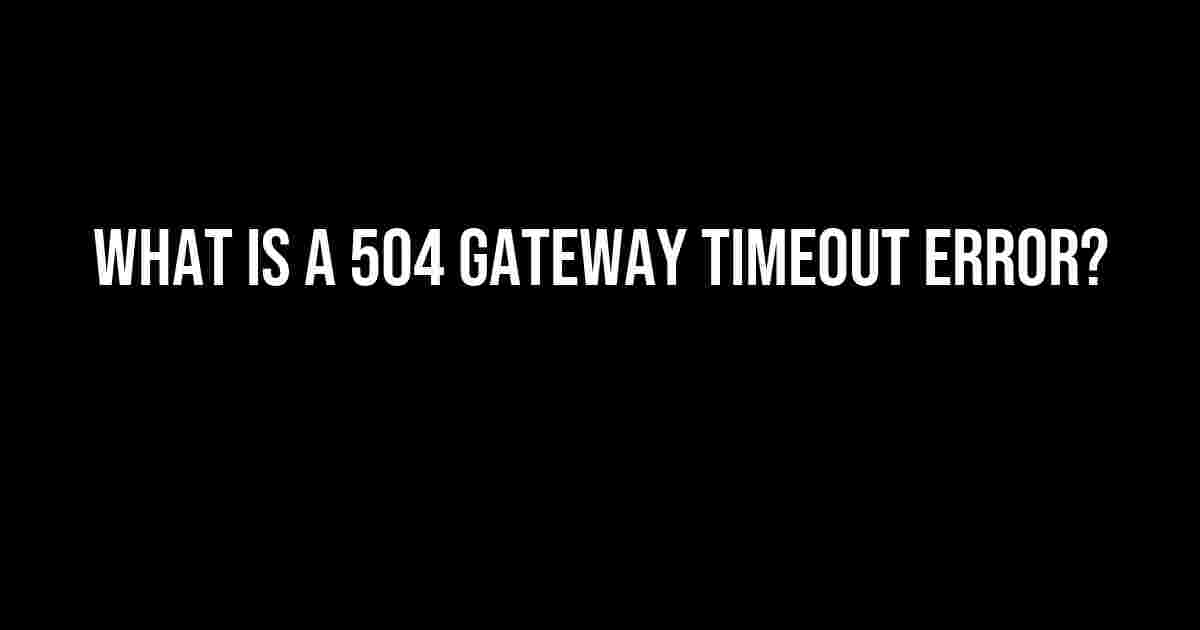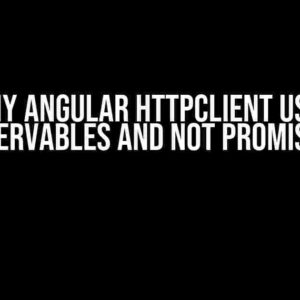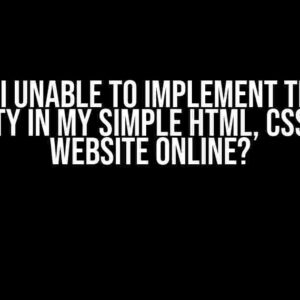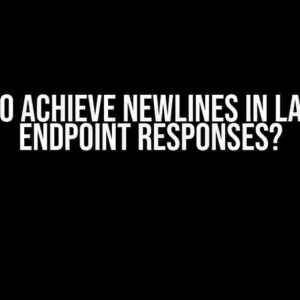Are you tired of dealing with pesky 504 Gateway Timeout errors in your web application? Do you use EventSource and Vercel for Server Side Events (SSE)? If so, you’re in the right place! In this article, we’ll dive into the world of Client-Side 504 Gateway Timeout errors, explore the causes, and provide step-by-step solutions to get your application up and running smoothly.
What is a 504 Gateway Timeout Error?
A 504 Gateway Timeout error occurs when a gateway or proxy server takes too long to respond to a request from the client (usually a web browser). This can happen due to various reasons such as network congestion, server overload, or misconfigured servers.
What is EventSource?
EventSource is an API that allows a web server to push events to a client (web browser) over HTTP. It’s commonly used for real-time updates, live updates, and Server-Side Events (SSE). EventSource uses the EventSource API to establish a persistent connection with the server, allowing it to push events to the client without requiring constant polling.
What is Vercel?
Vercel is a platform that enables developers to deploy, host, and manage modern web applications. It provides a range of features such as serverless functions, CDN, caching, and SSL encryption. Vercel is designed to simplify the development process, allowing developers to focus on building amazing applications.
How do EventSource and Vercel work together?
When using EventSource with Vercel, you can create Server-Side Events (SSE) that push events to the client in real-time. This is achieved by setting up an EventSource endpoint on your Vercel server, which allows the client to establish a persistent connection and receive events as they occur.
The Problem: Client-Side 504 Gateway Timeout
When using EventSource with Vercel, you may encounter a Client-Side 504 Gateway Timeout error. This occurs when the client (web browser) times out while waiting for the server to respond to an EventSource request. This can happen due to various reasons such as:
- Server overload or high latency
- Network congestion or packet loss
- Misconfigured Vercel server or Edge Network
- Client-side issues such as browser limitations or network connectivity
Symptoms of a Client-Side 504 Gateway Timeout
The symptoms of a Client-Side 504 Gateway Timeout error may vary depending on the browser and application. However, common symptoms include:
- The browser displays a blank page or an error message
- The EventSource connection is closed or terminated
- Events are not received or updated in real-time
- The application becomes unresponsive or slow
Solutions to Client-Side 504 Gateway Timeout
Don’t panic! We’ve got you covered. Here are some solutions to help you resolve the Client-Side 504 Gateway Timeout error:
Solution 1: Optimize Server-Side Performance
Ensure your Vercel server is optimized for performance. This can be achieved by:
- Optimizing database queries and transactions
- Caching frequently accessed data
- Using efficient algorithms and data structures
- Scaling your server resources (e.g., increasing instance size or adding more instances)
// Example: Optimizing server-side code using Node.js and caching
const express = require('express');
const app = express();
const cache = require('cache-manager');
app.get('/events', async (req, res) => {
const cachedEvents = await cache.get('events');
if (cachedEvents) {
res.json(cachedEvents);
} else {
const events = await db.query('SELECT * FROM events');
cache.set('events', events, { ttl: 300 }); // cache for 5 minutes
res.json(events);
}
});
Solution 2: Configure Vercel Edge Network
Configure your Vercel Edge Network to reduce latency and improve performance. This can be achieved by:
- Enabling Edge caching for static assets
- Configuring Edge headers for efficient caching
- Setting up Edge functions for serverless computing
// Example: Configuring Vercel Edge Network using vercel.json
{
"version": 2,
"routes": [
{
"src": "/events",
"dest": "/events",
"headers": {
"Cache-Control": "public, max-age=300"
}
}
],
"edge": {
"caching": true,
"functions": ["edge-function.js"]
}
}
Solution 3: Implement Client-Side Error Handling
Implement client-side error handling to handle errors gracefully. This can be achieved by:
- Catching errors using try-catch blocks
- Implementing retry mechanisms for failed requests
- Displaying error messages or fallback content
// Example: Implementing client-side error handling using JavaScript
const eventSource = new EventSource('/events');
eventSource.onerror = (event) => {
console.error('Error occurred:', event);
// Retry mechanism
setTimeout(() => {
eventSource = new EventSource('/events');
}, 5000);
};
eventSource.onmessage = (event) => {
console.log('Received event:', event.data);
};
Solution 4: Use a Load Balancer or CDN
Use a load balancer or CDN to distribute traffic and reduce latency. This can be achieved by:
- Configuring a load balancer (e.g., HAProxy, NGINX) to distribute traffic
- Using a CDN (e.g., Cloudflare, Akamai) to cache and distribute content
// Example: Configuring a load balancer using HAProxy
frontend http
bind *:80
default_backend servers
backend servers
mode http
balance roundrobin
server server1 10.0.0.1:80 weight 1
server server2 10.0.0.2:80 weight 1
server server3 10.0.0.3:80 weight 1
Conclusion
In this article, we’ve explored the world of Client-Side 504 Gateway Timeout errors when using EventSource with Vercel for Server-Side Events (SSE). We’ve discussed the causes, symptoms, and solutions to resolve this error. By implementing these solutions, you can ensure a seamless and efficient experience for your users.
| Solution | Description |
|---|---|
| Solution 1 | Optimize server-side performance |
| Solution 2 | Configure Vercel Edge Network |
| Solution 3 | Implement client-side error handling |
| Solution 4 | Use a load balancer or CDN |
Additional Resources
For further reading, check out these additional resources:
Don’t let Client-Side 504 Gateway Timeout errors hold you back! With these solutions and best practices, you can ensure a smooth and efficient experience for your users. Happy coding!
Frequently Asked Question
Get the scoop on Client-Side 504 Gateway Timeout with EventSource and Vercel (Server-Sent Events)! We’ve got the answers to your burning questions.
What is a 504 Gateway Timeout error, and why does it happen with EventSource and Vercel?
A 504 Gateway Timeout error occurs when a server (in this case, Vercel) doesn’t receive a response from another server (the EventSource) within a certain time frame. This can happen when there’s a congestion in the network or the EventSource server is slow to respond. Vercel has a default timeout of 30 seconds, after which it returns a 504 error.
How can I troubleshoot a 504 Gateway Timeout error with EventSource and Vercel?
To troubleshoot, check your EventSource server logs to identify any issues. Verify that your server is responding correctly and within the timeout limit. You can also try increasing the timeout limit in Vercel or implementing retry mechanisms in your EventSource server.
Can I configure the timeout limit in Vercel for EventSource requests?
Yes, you can configure the timeout limit in Vercel using the `timeout` property in your `vercel.json` file. For example, you can set it to 60 seconds like this: `{ “timeout”: 60 }`. This will increase the timeout limit for all requests, including EventSource requests.
How can I handle 504 Gateway Timeout errors in my client-side application?
You can handle 504 errors in your client-side application by implementing error handling mechanisms. For example, you can use a retry mechanism to retry the request after a certain interval. You can also display an error message to the user and provide an option to retry the request manually.
Are there any alternative solutions to using EventSource with Vercel?
Yes, you can consider alternative solutions like WebSocket or WebRTC for real-time communication. These technologies provide more robust and efficient ways to handle bi-directional communication between the client and server. However, they require more complex implementations and may have additional infrastructure requirements.





